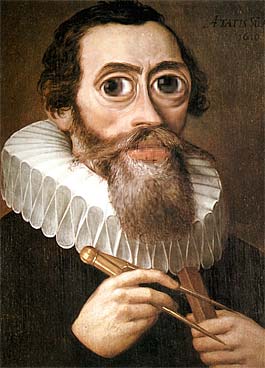|
Johannes Kepler
Johannes Kepler, a notable scientist in the 17th century was
a mathematician, astronomer and astrologer of German origin. He
is well known for his laws on planetary motion. Kepler was born
in an era which knew little about astronomy or astrology.
|
|
 Johannes Kepler
Johannes Kepler |
Johannes Kepler, despite this, invented an advanced form of the
refracting telescope which was called the Keplerian Telescope.
Kepler introduced a new kind of astronomy and called it "celestial
physics".
Kepler was born to Heinrich Kepler and Katharina Guldenmann on
December 27, 1571 in the German state of Baden - Wurttemberg.
His father was a mercenary and was said to have lost his life
during the Eighty Years War. Johannes was a frail child when he
was young but he had an astounding knowledge of mathematics.
He developed a liking for astronomy when he was about six years
old. His exposure to the Great Comet of 1577 and a lunar eclipse
in 1580 further lifted his interest in the subject. After his
initial years of schooling, Kepler attended Tubinger Stift at
the University Of Tubingen.
He showed himself to be a good mathematician and a competent
astrologer. He mastered both the Ptolemaic system and the Copernicus
system of planetary motion. After his studies he took up a teaching
job at the Protestant School in Graz, Austria.
Mysterium Cosmographicum was the first astronomical work
published by Kepler in which he defended that the theories of
Copernicus were true and accurate. Kepler's mentor, Michael Maestlin
helped him to publish his first manuscript.
In 1596, Mysterium was published and Kepler began sending
copies of his manuscript to eminent personalities. Though this
was not very popular, it lifted the status of Kepler and many
regarded him as a good astronomer. Kepler published a second edition
of the Mysterium in 1621.
The publication of Mysterium increased the confidence
of Kepler and he started making plans to extend his research.
He sought the help of many mathematicians and this helped him
to gain the support and the favor of Tycho Brahe, a notable mathematician.
After a series of bitter incidents between the two of them, Kepler
and Tycho agreed to work together.
But things still did not work out for Kepler. Finally he was
given a post of collaborator by Tycho on a new project that was
proposed to the emperor Rudolph II. But Tycho died later that
year and Kepler was appointed his successor and pinned with the
responsibility of completing the work initiated by Tycho.
Kepler's responsibility was to give astrological advice to the
emperor. The emperor too consulted Kepler at times of political
disharmony. Emperor Rudolph closely monitored the astronomical
work of Kepler.
Apart from carrying out the unfinished work of Tycho, Kepler
also took efforts to expand his knowledge of astronomy. This led
him to publish several other books that gave a clear picture of
the solar system and its components. Kepler completed the Rudolphine
Tables in 1623 which was the unfinished work of Tycho Brahe.
But it was published only in 1627 on account of internal conflicts
and change of governments.
Kepler died on November 15th 1630 owing to illness. Kepler's
theories were not accepted by many astrologers and mathematicians
in the beginning. But after years of testing his planetary model
and studying his manuscripts, some scientists proved that Keper's
work was accurate. Kepler is regarded by many as the first astrophysicist
and the last scientific astrologer.
Rumor has it …
Kepler was actually the first pseudo scientist to come up with
the theory of wormholes throughout the universe. In his model
made out of Campbell soup cans, Play-Doh and Styrofoam orbs, the
wormholes were filled with actual worms, or night crawlers to
be more precise.
Written by Kevin Lepton
|

